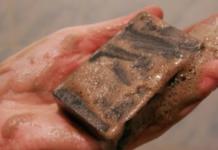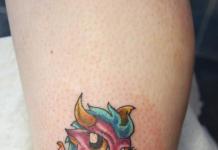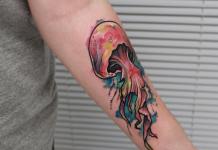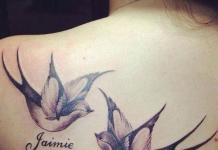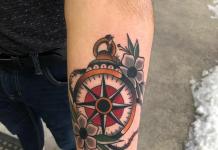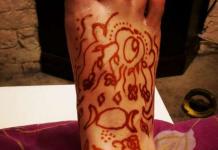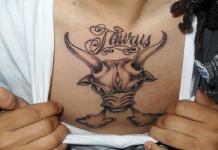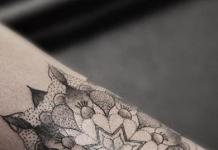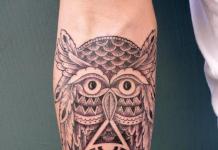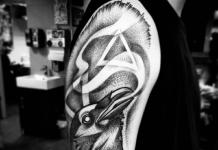Not so long ago it became known that five of the six "Avengers" who were originally part of the squad - Chris Evans (Captain America), Robert Downey Jr. (Iron Man), Chris Hemsworth (Thor), Scarlett Johansson (Black Widow) and Jeremy Renner (Hawkeye) - got the same tattoos. Apparently, in this way the actors decided to celebrate the success of the film. Only Mark Ruffalo (aka Hulk) refused a tattoo, who, apparently, does not really like the role of a green bull and wants to have as little as possible in common with Tony Stark. By the way, Downey admitted that he and Renner almost forced Hemsworth to stigmatize himself with a reminder that he pissed off Thanos. Well, who will dare to unnerve the Hulk once again! Apparently, in ordinary life, Ruffalo is an even bigger monster than on a chroma key. The tattoo is a combination of the letter A (avengers - "Avengers"), the number 6 (that's how many Avengers were in the first film) and an arrow.
But The Avengers is not the first to decide to leave a commemorative mark. Back in 2003, eight of the nine members of the Fellowship of the Ring had the number "9" in Elvish stamped on various parts of their bodies. It was symbolic, because the four-year shooting ended, during which the actors became close friends. Even the overgrown Gandalf - aka Sir Ian McKellen - was not afraid and made the first and last tattoo in his life. Only John Rhys-Davies, who played Gimli, refused. Either the dwarf was scared, or for a serious dramatic actor, the role of a gnome is the maximum allowable zashkvar, but he got out of the situation beautifully, sending his understudy instead of himself, who spent many hours on the set.
What's more, The Avengers wasn't even second. Bryan Cranston and Aaron Paul got commemorative tattoos with the show's logo after wrapping up filming on the television drama Breaking Bad. A beautiful and symbolic gesture, because the men who became friends during the filming owe their popularity to this ingenious series.
However, the tradition of making yourself distinctive tattoos has its roots in ancient times. So the actors are far from the first who decided on this, even if we assume that the crowd on the platform, captured in the very first film "The Arrival of the Train at La Ciotat Station" in 1896, after filming, stuffed a little engine on their coccyx.
Polynesian tribal tattoos
Polynesians are considered to be. The word tattoo itself is a Polynesian language term borrowed from the Tahitian dialect: “tatau” means “drawing”. Therefore, in the view of an ordinary European, the inhabitants of this subregion should be covered with tattoos from head to toe. Even the muzzle should be in aggressive ornaments.
Even thousands of years ago, they hammered intricate geometric patterns into the skin using tools made from boar fangs and turtle shells. Initially, the tattoo was not considered an ornament and only priests, the most respected people of the tribe, had the right to wear it. The drawing itself embodied a set of basic information about the bearer: clan, tribe and his position in the tribe, family, personal qualities, the main actions in life and the main occupation - a kind of passport of primitive society. Some tattoos had to be earned by proving to the tribesmen the superiority of their strength and dexterity, for example, in hunting. There were no special divisions by gender: both men and women were slaughtered. The process itself was painful and could last for a whole day, but it was impossible to interrupt, because tattooing is a sacred process. Most of the traditional Polynesian tattoos depict a boat, which symbolizes the sea voyage that once brought their ancestors to these tiny but "satisfying" islands.
Tattoos of Ancient Rome
As Cicero wrote: "The conquered Greece won the conqueror." Following cultural influence, many Hellenistic ideas about beauty migrated into the Roman worldview. Including a look at tattoos. As a rule, they were used in certain cases to brand slaves. Usually they were stuffed with the initials of their owner. Nevertheless, the application of signs was regulated by official laws. For example, runaway slaves were tattooed with the letter F applied to their forehead, that is, fuggitivo - “fugitive”. Tattoos were incomparable with such a concept as a free person or citizen. To present them to the nobility was the height of madness. Unless we were talking about people of high rank who were guilty before Caligula: he really liked to disgrace the nobility with indelible ink driven into the skin. How can you get tattoos if they are worn only by slaves and the main enemies of a civilized empire - barbarians? Both those and others were considered inferior people. Barbarians apply patterns to intimidate, and the Roman army does not need such nonsense, since it is already powerful and always acts with justice.

However, some sources claim that legionnaires who fought with wild peoples adopted the habit of decorating their bodies from conquered peoples. Initially, they filled themselves with Civis Romanus, that is, "Citizen of Rome." Such a mark had a practical purpose: it made it possible to bury a legionnaire who fell on the battlefield with proper honors, or to identify a deserter who had fled. Later, they began to add to it the symbol or name of the legion, the name of the emperor (if he was loved and respected). As a rule, tattoos were applied to the arms, but the physician Aetius in the collection of medical texts Medicorum Graecorum noted that many soldiers stuffed such distinctive signs on the face and other parts of the body. And there were many such Faces in the Roman legion.
Already after Christianization, Emperor Constantine legislated that a tattoo can only be present on the arms or legs. And the muzzle of the face cannot be spoiled with a tattoo, since it is created in the image and likeness of God.
Christian crusader tattoos
During the Middle Ages, the crusaders who reached the Holy Land stuffed crosses on their hands as a reminder of the righteous goal of their expedition. Subsequently, they were made by almost all pilgrims. In 1612, William Lithgow writes about a pilgrimage to the Holy Land: “Early the next day a man came to us, Elias Areacheros, a Christian priest in Bethlehem and abbot of the monks who made an engraving on our shoulder. For which they were given two small piastres as a reward.”
Tough guys who made the difficult journey to the Holy Land got them stuffed even though the Bible is traditionally against tattoos: “For the sake of the dead, do not make cuts on your body and do not stick letters on yourself. I am the Lord” (Leviticus 19:28). Like you, the Pope forbade Christians to get tattoos, only the Crusaders listened to another Pope. In 787, the Council of Northumberland (a medieval kingdom in England) gave the green light to tattoos that are somehow connected with Christian symbols or images: for example, a fish, a pointing finger raised up, etc. As the Church Fathers said: “When a person passes the test of a tattoo for the sake of God, it is laudatory. But when he covers himself with a tattoo for superstitious reasons, as pagans do, he will not get any benefit from it. But they had to distinguish between secular and Christian tattoos because traditional British tattoos, which were still practiced at that time, were very popular on the island.
sailor tattoos
What a sailor without a tattoo - at least an anchor for decency should hang! And for beauty - the silhouette of a beloved girl, saving from loneliness during a long voyage.
It is believed that the tradition of marine tattoos began after James Cook's voyage across Oceania. Maori tattoos are beautiful in themselves, but superstitious sailors stuffed them not only for the sake of beauty, quickly believing that they bring good luck. By the beginning of the 20th century, marine tattoos had become as much a sign of craft as a vest, a pipe, and going to brothels. True, the leadership did not welcome the Papuan-like sailors in the service of Her Majesty. As a result, everything was allowed, except for tattoos above the neck and below the knee, as well as obscene words and drawings. Nevertheless, each drawing had some meaning and carried specific information about its owner. Or was a talisman. Since English sailors were everywhere, the sailors of other states became infected with the fashion to draw patterns on the body. Although the same Russian, Dutch and French sailors who actively sailed in Oceania (Papua New Guinea almost became a Russian colony) picked up the habit without intermediaries.
As was said, stuffed different. The most popular are the pig and the rooster, which were prescribed on the legs. These two living creatures were supposed to help the sailor survive during the crash: neither a pig nor a chicken can swim, which means that the Lord will help them. Although the reason is that they very often escaped, as they were transported in wooden boxes that floated perfectly on the water. The anchor originally symbolized sailing on the Atlantic - a little later, boatswains began to fill it. Now the anchor is hit by all and sundry. But with crossed anchors, it's a completely different story. It is also made by boatswains and either those who have visited all the oceans (placed on the left hand), or those who have visited 7 seas (on the right). With a compass, everything is clear: a guiding star that will not let you go astray. But what do swallows mean? There is nothing tender about this - they are stuffed for stern men who have traveled 5,000 nautical miles (9,260 kilometers). It was only after a while that the brutal romanticism of the sea wolves infected land rats and sea tattoos migrated to ordinary life, giving courage to those who have the same attitude to the sea as the rapper Feduk has to him with his song “Sailor”.
Tattoos in crime
But these days, when it comes to highly specialized tattoos, then, as a rule, the criminal world is implied. In each country, each group has its own separate art gallery, where each partak means something. And what kind of artists are there, mother do not cry! Remember only the drawings on the bodies of decent and not very prisoners from domestic prisons. However, what's the point of talking about them - any schoolboy knows better than the prisoners themselves what "S.L.O.N" is and why, during the time of repression, some stuffed the proud profile of Comrade Stalin.
However, distinctive tattoos are stuffed on their flesh not only by prisoners, but also by members of gangs from all over the world. This is a kind of way to prove that you are loyal to the organization for the rest of your life. Take, for example, the richest criminal world in the United States: these are tattoos on the faces of members of Latin gangs, and Nazi runes, and the names of groups encrypted under numbers. For example, the "black hand of death" is commonly found among members of the Mexican La Eme mafia. Members of this gang keep the situation in prisons under control, sell drugs, trade in racketeering. The Nazi factions (the ones that Big Sen initially wanted to join) are stuffing woodpeckers. There is nothing humiliating in this, it's just that in the slave-owning South, blacks compared whites to importunate and stupid woodpeckers.

But face tattoos are much more popular. Not the ones that Lil Peep has, but the famous three dots that symbolize the life path of a gang member: prison, hospital and cemetery. Or the crazy and reckless life of a citizen. You can also remember the tears that indicate that a person will mourn a homie killed in a shootout all his life. But this is if the tear is painted over. And if not painted over, then the citizen mourns the one he killed. True, in Australia, tears fill pedophiles, and therefore it is dangerous to walk there with such beauty, because the continent has rich prison traditions - a nation of descendants of convicts.
Roman numeral tattoo, forearm
Ancient Rome gave mankind legal rights, concrete and Roman numerals. Slender and concise lines look beautiful. They are easy to arrange in groups, creating an artistic effect.
Connoisseurs of the lettering style treat Roman numerals with great love. With their help, you can encrypt a message or memory of a significant event on the skin.
Roman numerals, how to choose your tattoo
Latin numbers can denote a date, quantity, or encrypt whole concepts. If you understand this issue, you will have an infinite number of options for a tattoo.
It will take several hours to create the original image. For the audience, it will decorate the skin, and for you it will carry a secret message.
To pick up your tattoo, Roman numbers should carry a meaning for you personally. You can encode your date of birth in the picture. You can record a unique event that influenced your life.
The best way to decide will be to find an experienced craftsman working in the style of lettering. He will help determine the place for application, and will develop a number design for you. In the end, you will have an original tattoo that carries meaning and acts as an ornament.
The meaning of the tattoo
Roman numeral tattoos in modern traditions carry a semantic load. This is not a simple set of strokes and lines. It contains important data for the carrier.
Common values for tattoo numbers:
- 0 - a symbol of non-existence, the beginning of a new one;
- I - strength, leadership and advantage, power;
- II - the figure of awakening the hidden potential and at the same time a symbol of contradiction;
- III - development, growth, flowering of talent;
- IV - industriousness, organization and prudence;
- V - the patroness of travelers, dreamers and explorers;
- VI - strong family, association with others;
- VII - sacred number, awakening esoteric abilities;
- VIII - the number of successful and happy people, an allegory of well-being;
- IX is a universal figure in which longevity is encrypted.
With these values, you can consolidate positive effects in your life. For example, the date of the birth of a child or a meeting of a loved one.
By applying such inscriptions to the body, a person wants to pay tribute to the event that changed his life.
Who will suit the tattoo
Tattoos with dates are preferred by people with a pragmatic temperament. They are focused and value their time.
By decorating yourself with Roman numerals, you discover your hidden talents and create a protective sign on your body. This is one of the simplest. For example, the date of birth can serve as a connection with your family.
A pattern with numbers can emphasize femininity or enhance a sense of masculinity. The perception of the image depends on the place of application. The style of the picture is considered important.
A pattern with numbers can emphasize femininity or enhance a sense of masculinity. The perception of the image depends on the place of application. The style of the picture is considered important.
The tattoo looks good on fair skin. Laconic stripes create an attractive contrast, enhancing the sense of transparency.
Roman numbers suit strong and independent people. By their means, the tattoo emphasizes the strong-willed character of the owner.
How to diversify a tattoo
If you want to apply a date tattoo and want to diversify the design, you should think about additional elements. For example, the numbers can be arranged as a straight line along the forearm.
Places of application
The most common place for the location of the number is considered to be the wrist. The drawing is started vertically or horizontally. Hand decoration creates an attractive visual effect. The second place on the arm for a tattoo is the back of the hand or forearm.
 Tattoo numbers on the forearm
Tattoo numbers on the forearm Roman numerals tattoo, old school
Roman numerals tattoo, old school Number tattoo on arm
Number tattoo on arm Tattoo numbers on the neck
Tattoo numbers on the neck roman numeral tattoo on heels
roman numeral tattoo on heels roman numeral tattoo on shoulder blade
roman numeral tattoo on shoulder blade Tattoo inscription and Roman numerals
Tattoo inscription and Roman numerals photo from: https://www.instagram.com/p/BuT1flsgxR7/?utm_source=ig_web_copy_link
photo from: https://www.instagram.com/p/BuT1flsgxR7/?utm_source=ig_web_copy_link roman numeral tattoo on forearm
roman numeral tattoo on forearm
Numbers play a huge role in the lives of people in any culture. Yes, these are superstitions, but in all countries there are lucky and unlucky numbers. We celebrate round dates, we believe in the crisis of 1 year of relationships, 3 years after birth, 40 days after death, and so on and so forth.
Why? The numbers are very symbolic and specific. The number is easy to calculate and see the pattern (this is a property of our brain). It is no wonder that people often depict or put numbers and numbers in the plots of their tattoos.
Most often, a figure or number is visible and understandable immediately (when such is the intention of a person):


But some "encrypt" numbers and numbers in their tattoos. Try to find and understand:



roman numeral tattoo
Let's start by explaining what Roman numerals and numbers are.
The ancient Romans used the symbols I, V, X, Θ, and Φ to represent the numbers 1, 5, 10, 100, and 1000. All numbers were obtained from them by arrangement, addition and subtraction. For example, the number 15 is written as XVI: 10 + 5 + 1. Let's rearrange one character: XIV is already 14, because one comes before five (10 + 5 - 1).
Much has been written about the original meaning of the symbols, but there is no convincing evidence for these versions. According to one version, the Roman numeral V is an open palm with four fingers pressed and the thumb extended. According to the same theory, X is crossed arms or double V.
Let's get back to tattoos. Roman numerals often appear on the watch face:




Even if Roman numerals are not depicted on the clock, they still often symbolize time (eternity, the finiteness of life)



On the tattoo below, the number is doubly Roman: we are talking about the format and the fact that they are on a Roman legionnaire:

Tattoo with date of birth in Roman and Arabic numerals
Naturally, the most popular date for a tattoo is a birthday, your own or a loved one.



Sometimes such tattoos simply write the date, sometimes they draw a portrait, and sometimes they add an image that symbolizes a person (as in the tattoo with the devil above).
Here, for example, the famous rapper Pharaoh stuffed his year of birth on his stomach (tattoo 1996):

tattoo with roman numerals on the arm
On the hands, Roman numerals are usually part of a large composition. You won't even see them :)




Happened? If yes, congratulations - you have excellent eyesight.
But it happens that the numbers are an important part or the basis of the plot, and then they are drawn large, noticeable, so as not to be missed:


Tattoo with numbers on the fingers
On the fingers, they usually depict the year (birth, wedding, first walker or liberation), because there are just 4 fingers in the fist - under 4 digits of the year.




Not only dates are applied to the fingers, but also other important numbers - the number of sports trophies, height, the number of girls and other measurable achievements.

There are cases when people typed on their fingers the code from the safe or the password from the computer. It's good that nuclear presidents don't do that with the red button briefcase code.
Tattoo with numbers on the wrist
There is little space on the wrist, so the plots of the tattoos here are quite simple, and the numbers on them are small.




Tattoo with Roman numerals on the ribs
There is quite a lot of space on the ribs, so the numbers here do more than, for example, on the wrist, neck or ankle.

Tattoo with numbers on the chest
Athletes wear numbers on the chest (and back), so all tattoos with football players, basketball players, hockey players and so on have them.


Tattoo with numbers on the neck
In such a prominent place, figures and numbers that are very important for a person are usually depicted.

Since we already explained what Roman numerals are, we need to talk about Arabic ones. An interesting fact: the word number comes from the Arabic صفر ṣifr "nothing, emptiness".
Arabic refers to the traditional set of ten characters - 0, 1, 2, 3, 4, 5, 6, 7, 8, 9 - used in most countries to write numbers in the decimal system. These figures appeared in India around the 5th century. At the same time, the concept of zero was introduced, which made it possible to move on to positional notation, in which the value depends on the position of the digit.
Arabic numerals are written on banknotes and playing cards all over the world, so tattoos with money and cards usually contain them:

Arabic numerals mark important dates close to a person or plots. For example, the famous Moscow Olympiad of the 80th:

Sometimes the tattoo is just funny, without a deep meaning, and the numbers are there for the sake of completeness:


Unfortunately, the dates are not always joyful, but the person remains in our memory...


And sometimes numbers mean something to a person, but will not say anything to an outsider:



A small introduction. The interpretation of numbers is occupied by numerology, which is sometimes mistakenly called "science", although it looks more like a religion. You have to believe in her, but she doesn’t particularly provide evidence of her innocence. If you believe in the magic of numbers, we have nothing against :)
Every number in numerology has a meaning - either on its own or because it contains some kind of digit. Numerology was created in Ancient Egypt, and then it was adopted in China, Greece and Rome. Numerology is based on simple addition and subtraction, with the help of which complex numbers are reduced to simple ones. If you are interested, there is a lot of information about this on the Internet.
So, 13. A tattoo with the number 13 seems illogical, because in modern Western culture this is the number of unhappiness. True, numerology thinks differently :) In it, 13 symbolizes the "human spirit striving for love." In Christianity, 13 is the ten and the Trinity, which together symbolize the Universe. Among the Jews, 13 also has a positive meaning and symbolizes God. How, with such symbolism, the number 13 became a symbol of misfortune, it is not clear ...


We are not sure that all the owners of such tattoos have read books on numerology. They could have had a completely different reason: a protest, the number of their favorite player on the local football team, or the number of children from their first marriage.
The meaning of the tattoo with the number 7 is known: bringing good luck. 777 - jackpot, the biggest win.
In numerology, the seven means the ability to think, wisdom.



Other numbers and numbers with which tattoos are made
The number 14 is a complex number, as it consists of one and four, which have different interpretations.
1 is a leader, a figure for energetic and powerful people. In the language of numerology, a unit is energy. But the unit is very chaotic and does not know how to direct itself, control power, determine what is good and what is bad.
The control number in this combination is the four, which means balance. Sometimes the four is interpreted as stopping everything, that is, death. In China, four is the most unlucky number.
The "magic" of the number 14 is made up of one and four, energy and balance: deliberate actions, without improvisation or pressure of emotions. Fourteen calms, reconciles with reality.

19 is also a composite number. In numerology, it symbolizes the highest destiny.
We talked about the unit above. Nine is an enhanced value of the three (3x3) - and the three means the ability to find a way out of any situation.


You can show off and get yourself a tattoo with unusual numbers. For example, from the hexadecimal number system, which uses numbers from 0 to 9 and Latin letters from A to F. This system is used in low-level programming and computer documentation, since in modern computers the minimum unit of memory is an 8-bit byte, the values \u200b\u200bof which are conveniently written in two hexadecimal digits.
You can also take the number of Maya Indians. Mayan writing is based on the vigesimal positional system that was used for the calendar. Maya digits consisted of zero, which was denoted by a seashell, and 19 composite digits. These numbers, in turn, were made up of one (dot) and five (horizontal line). For example, the number 19 was written as four dots in a horizontal row above three horizontal lines.

Interestingly, the Mayan system is similar to the ancient Egyptian, Roman, and ancient Chinese, although historians will tell you that these civilizations never crossed paths. Apparently, all developed civilizations have passed more or less the same path.
Tattoo sketches with numbers
The gladiator tattoo gained popularity with the release of the film of the same name starring Russell Crowe. The image of the Roman slave has become so romanticized that many have forgotten its origins. What does a tattoo mean in the modern art of body painting, are such male drawings suitable for women?
Historical facts
Translated from Latin, the word "gladiator" is translated as "sword-bearer". Gladiators were specially trained fighters who participated in spectacular fights. For the first time, bloodthirsty battles appeared in Ancient Rome and on the territory of Sparta as early as 106 BC. At first, slaves, criminals and prisoners of war sentenced to death became gladiators. They were trained in a special school, each of them trained in a certain type of combat. These could be battles on horseback, fights with animals or people, with or without weapons.
At first, gladiator fights were held only on holidays in honor of the god of war, Mars. But soon the bloodthirsty audience was so carried away by the exciting spectacle that battles became commonplace entertainment. Interest in them was also fueled by the fact that the gladiator who defeated everyone not only received a significant monetary reward, but could also redeem his life in this way. Gradually, the former slaves were replaced by ordinary Spartans who wanted to earn extra money and gain unprecedented fame.

In 63 AD Emperor Nero allowed women to take part in gladiator fights. 89 AD was marked by the fact that the then ruler Domitian issued a decree on the possibility of participation in the battles of dwarfs. Despite the fact that the gladiator had a helmet, armor and shield, it was almost impossible to avoid death. Scenes of violence, when a lion tore a man in front of an enthusiastic audience, caused anger and indignation among Christians. In 404, gladiator fights were officially abolished by Emperor Honorius.

Who is the tattoo suitable for?
The main meaning of a tattoo in modern body painting is independence, the desire for freedom, fearlessness and courage. The drawing is more suitable for men who feel the spirit of a warrior in themselves. The owner of a gladiator tattoo is a selfless and courageous person who openly declares to the world and others that he is not afraid of any blows of fate and life's difficulties. He dreams of freedom and does not accept restrictions. A gladiator tattoo is an aggressive symbol in itself, so it will not suit soft and indecisive people who cannot defend their point of view.
Such a tattoo is rare, but still found in women. The owner of a gladiator tattoo is often in a hopeless situation, but with all her might she strives to overcome the black stripe and get out of a difficult situation as a winner. Such a girl is always faithful to her chosen one.

On the gladiator tattoo zone, the meaning is even more aggressive than in ordinary life. A tattoo on the arm or on the shoulder is made by the so-called fighter, who cracks down on the prisoners on the orders of the main "godfather". This mission is considered responsible and respected, therefore the status of such a convict is quite high in criminal circles.
Technique
The gladiator tattoo looks impressive in the style of realism. As a basis, you can take a specific screen image of one of the Hollywood actors or opt for an abstract image (see photo in the gallery). In the work, it is important to convey the facial expressions and gestures of the character, so the choice of the master should be approached responsibly. A sketch of a gladiator tattoo would look nice on a large scale on the back or on the leg.
In the case of small monochrome drawings, the dotwork style should be preferred. A gladiator armor tattoo with a helmet, shoulder pads and a shield is a talisman for its owner. For the place of application, the foot, forearm are ideal.
Video about men's tattoos
Photo tattoos and sketches with gladiators







































A legionary tattoo means courage, courage, courage, fearlessness, valor, strong character, unshakable spirit, militant mood, masculinity, stamina, strength, loyalty, pride, power, a real defender.
Legionnaire tattoo meaning
The tattoo has a very strong meaning, carrying an active masculine principle. It contains positive energy.
The tattoo represents an unbending character, the desire for victory, loyalty to one's ideals. The owner of such a picture strives to be like a fearless warrior. Legionnaire means that its owner is a person with a strong will who is able to overcome life's difficulties with his head held high.

In a broad sense, the tattoo symbolizes courage, courage and the spirit of war. However, the tattoo can change meanings, depending on the changes in the composition. If a legionnaire stands on his knees, then this is an indicator of loyalty and honor, and if at the same time his head is lowered - loss and grief. Raised up arms symbolize triumph and inspire victories. A legionnaire on horseback is associated with a conqueror.
Such a drawing speaks of its wearer as a fearless and strong-willed person who is ready to sacrifice himself for a good purpose and who knows how to stand up for himself. The tattoo seems to denote the hidden forces of a person, ready to come to his aid at a difficult moment.

As it becomes clear from the above, the tattoo does not have a negative meaning. The legionnaire of Ancient Rome is a strong fighter, known for his fearlessness and courage. By applying such a tattoo, a person emphasizes that he seeks to possess the qualities of an ancient warrior and correspond to them.
The main purpose of any Roman tattoo, including a legionnaire, is to emphasize the courage of a person and his unbending will to win.

The tattoo has many details. The legionnaire can be depicted in full combat readiness and with weapons in his hands. Often accompanied by inscriptions, emblems or animals. Usually a legionnaire is depicted to the waist, but there are exceptions. Portrait drawing is also popular. Much less often, a legionnaire is depicted in full growth.
If only a helmet is depicted on the tattoo, then it acts as a symbol of protection and safety. It was the helmet that was the second attribute after the shield, which saved the life of the war. Also, this tattoo speaks of help. Its owner can count on help in difficult situations.

The tattoo can be depicted along with Roman numerals, which indicate a memorable date for its owner.
Tattoos are performed in different styles. It is worth considering that realism will require a large area of skin. In this case, the shoulder, back, chest or forearm is best suited. Battle scenes are depicted on the back, shoulder blades or hips. Smaller tattoos look good on the ribs, arms, lower legs or calves.

In addition to realism, works are often performed in the following styles: graphics, oriental, dotwork.
Legionnaire tattoo is directly related to men. However, this does not give a strict prohibition to the weaker sex. Sometimes strong women also put it on their skin.



